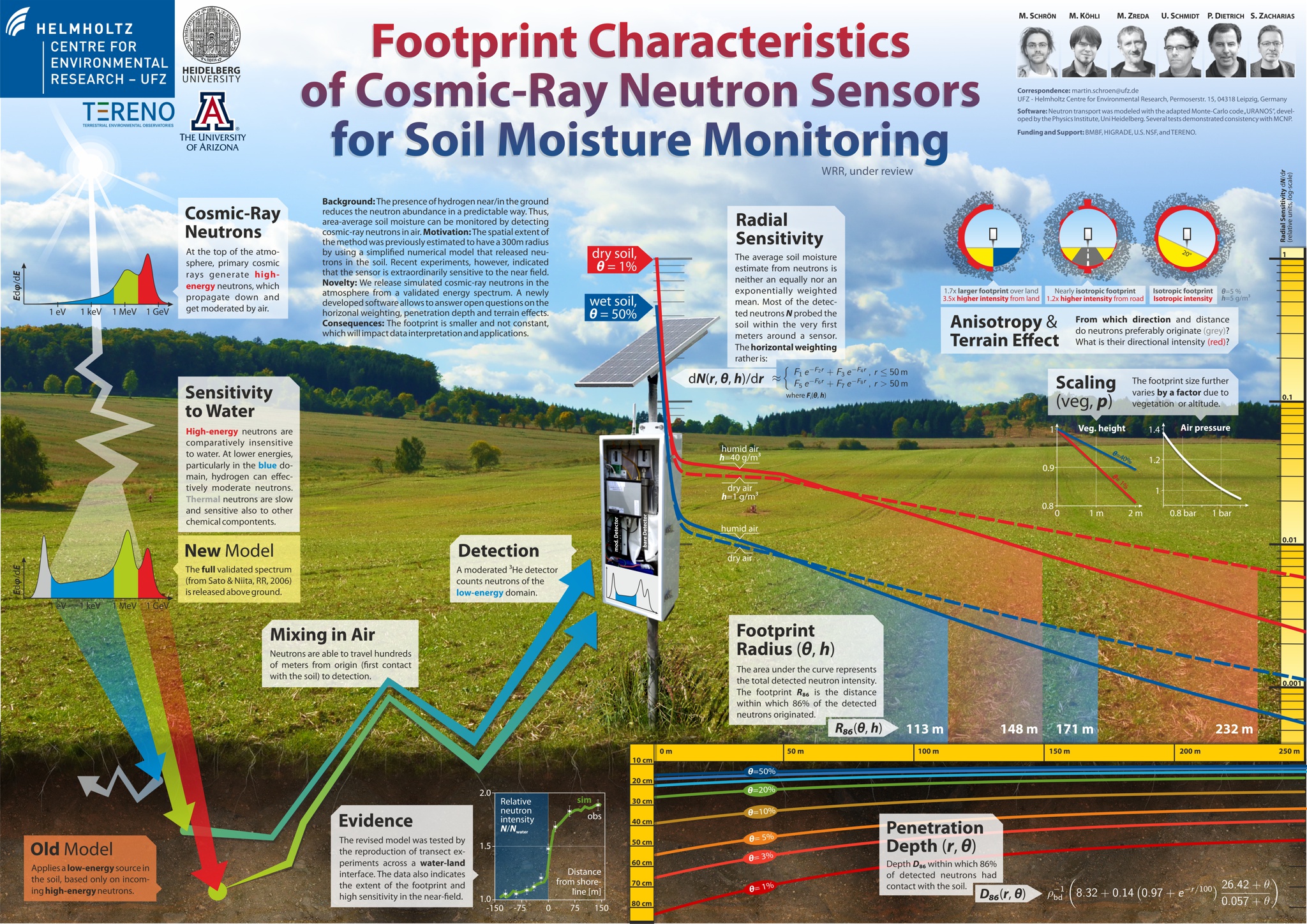Footprint Characteristics Revised for Field-Scale Soil Moisture Monitoring with Cosmic-Ray Neutrons
M. Köhli 1,3, M. Schrön 2,3,*, M. Zreda 4, U. Schmidt 1, P. Dietrich 2, and S. Zacharias 2
1 Physics Institute, Heidelberg University,
2 Department of Monitoring and Exploration Technologies, UFZ Leipzig
3 These authors contributed equally to this work,
4 Department of Hydrology and Water Resources, University of Arizona.
* Corresponding author,
martin.schroen@ufz.de
Footprint characteristics revised for field-scale soil moisture monitoring with cosmic-ray neutrons.
Water Resour. Res., 51, doi:10.1002/2015WR017169
Abstract
Cosmic-ray neutron probes are widely used to monitor environmental water content near the surface. The method averages over tens of hectares and is unrivaled in serving representative data for agriculture and hydrological models at the hectometer scale. Recent experiments, however, indicate that the sensor response to environmental heterogeneity is not fully understood. Knowledge of the support volume is a prerequisite for the proper interpretation and validation of hydrogeophysical data.
In a previous study, several physical simplifications have been introduced into a neutron transport model in order to derive the characteristics of the cosmic-ray probe's footprint. We utilize a refined source and energy spectrum for cosmic-ray neutrons and simulate their response to a variety of environmental conditions.
Results indicate that the method is particularly sensitive to soil moisture in the first tens of meters around the probe, whereas the radial weights are changing dynamically with ambient water. The footprint radius ranges from 130 to 240 m depending on air humidity, soil moisture and vegetation. The moisture-dependent penetration depth of 15 to 83 cm decreases exponentially with distance to the sensor. However, the footprint circle remains almost isotropic in complex terrain with nearby rivers, roads or hill slopes.
Our findings suggest that a dynamically weighted average of point measurements is essential for accurate calibration and validation. The new insights will have important impact on signal interpretation, sensor installation, data interpolation from mobile surveys, and the choice of appropriate resolutions for data assimilation into hydrological models.
Supplementary Movies
Cosmic-ray neutrons are impinging the ground continously. In the atmosphere neutrons are released with different energies, from which 1 to 1000 eV (green) can be detected by the cosmic-ray sensor. Neutrons lose energy mainly by elastic scattering interactions with nuclei in air, soil or water.
To demonstrate the effect of moist soil interacting with the neutrons, point sources of cosmic-ray neutrons were released above pure water and dry soil. The visualisation shows three main characteristics of neutron behaviour in the environment.
- Intensity is higher over dry soil than over water.
- Mixing range is larger over dry soil than over water.
- Penetration is deeper in dry soil than in water.
Footprint radius, depth, and sensitivity
The following movie shows the locations of interaction of cosmic-ray neutrons (black dots) with the ground, before they get detected by a central sensor. Histograms (right) show at which distance or depth detected neutrons had their first contact with the soil. Apparently, the detector is particularly sensitive to the first meters around the sensor. The footprint (red) is denoted as distance or depth within which 86% of the detected neutrons originated. The more neutrons are added to the simulation, the better is the statistical quality of the results.
Acknowledgements
URANOS was developed for the project "Neutron Detectors for the MIEZE method" funded by the German Federal Ministry of Education and Research (BMBF), grant identifier: 05K10VHA. Source code and support for URANOS can be provided by M. Köhli. MS acknowledges kind support by the Helmholtz Impulse and Networking Fund through Helmholtz Interdisciplinary School for Environmental Research (HIGRADE). The contribution of MZ has been funded through the COSMOS project by the U.S. National Science Foundation, grant identifier: ATM-0838491. The present work benefited from stimulating and critical discussions with Darin Desilets (Hydroinnova LLC). MK thanks A. Nesterenok and T. Sato for fruitful discussions. MS thanks J. Mai, L. Schüler, J. Weimar, and U. Wollschläger for kind assistance and valuable comments. The research was funded and supported by Terrestrial Environmental Observatories (TERENO), which is a joint collaboration program involving several Helmholtz Research Centers in Germany.
Related: EGU 2015 Poster

